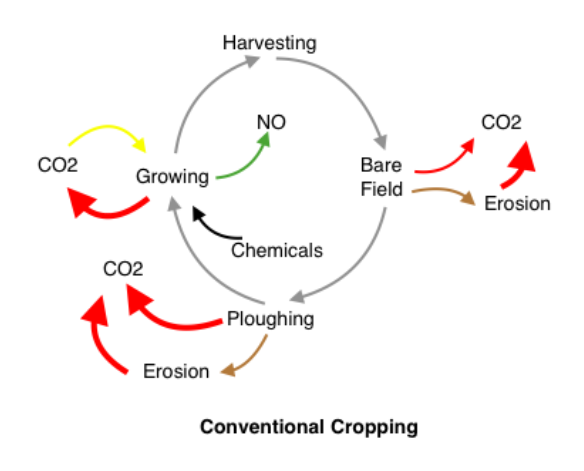The Carbon Cycle & Agricultural Greenhouse Gasses
"Carbon is the currency for most transactions within and between living things." - Christine Jones
"the trouble isn't the carbon itself; it's that there is too much of it in the air rather than in the ground, where it lends fertility to the soils." - Judith Schwartz
Industrial Agriculture has resulted in enormous environmental damage including significant greenhouse gas emissions. By constantly fighting against nature's way of doing things nature's balanced carbon cycles are broken. The combination of tillage and chemical agriculture has caused between 50 and 80% of soil carbon to be lost from the soil, where it performs functions vital to life on the planet, and now to reside in the atmosphere and ocean. By changing to mimicking and working with nature we are able to fix and indeed accelerate these broken carbon cycles and reduce the environmental and climate damage.
"Soil is the climate solution." - Finian Makepeace, Kiss the Ground
Real carbon cycles are of course more complicated than those depicted in the diagrams below and they link in with water cycles and other mineral cycles but these simplified diagrams highlight the complexity and lack of cycling in Industrial Agriculture with the simplicity and balanced carbon cycling of Regenerative Agriculture.


"On our ranch everything revolves around carbon." Gabe Brown
"Accelerated topsoil formation is the great work of our time." - Abe Collins, Soil Carbon Coalition


Much is made of the methane that ruminants belch as they break down plant cellulose but this is part of a natural cycle. There have been 100s of millions of ruminants on the planet for millions of years and they never pushed up greenhouse gas concentrations. Interestingly atmospheric methane levels have only begun rising since industrial times. Nature evolved mechanisms for dealing with natural methane emissions, such as the hydroxyl radical (OH) in the atmosphere that breaks methane down rapidly.
Indeed as these ruminants evolved with the grasslands of the world exactly the opposite happened, together they sequestered the mass of carbon that was once in the soil below those grasslands, the carbon that our tillage has now released into the atmosphere. As this image from an independent carbon lifecycle assessment done on White Oak Pastures farm shows properly managed cows on grass are part of a natural grassland carbon cycle. This is very different to monoculture cropping and animal confinement (feedlots) both of which take carbon from the soil and emit it into the atmosphere without the accompanying sequestration.

To reduce emissions and reinstate natural carbon cycles we need to:
- Stop ploughing
- Stop applying synthetic fertilisers
- Stop monocultures
- Stop spraying chemical
- Ensure our soils are covered with crops at all times
- Get ruminants into crop rotations
- Get ruminants grazing on the fields that used to provide grain for feedlots
- Get high impact, long rest, planned grazing on grasslands
- Close feedlots down
"Soil carbon is the key driver for farm profit" - Dr. Christine Jones
Video: Dr. Christine Jones explains how increasing diversity and decreasing nitrogen puts carbon in the soil and increases production
